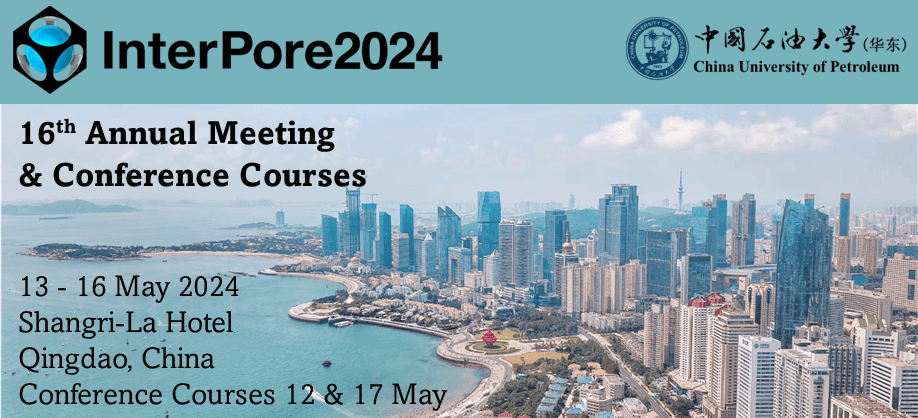Speaker
Description
Large-scale (TWh) renewable energy storage is crucial to achieve a net-zero green world. To accomplish this, renewable energy can be converted into hydrogen (H$_2$) and stored in large-scale volumes in giant subsurface geological reservoirs. The feasibility of underground hydrogen storage in porous reservoirs highly depends on the flow and transport behaviour of hydrogen during subsequent injection and withdrawal cycles in the reservoir, which is governed by complex pore-scale processes [1-3].
Recently, several experimental studies [4-8] have taken place, which allow for the characterization of hydrogen transport properties in the subsurface. However, some discrepancies were found in contact angle characterization results using different measurement techniques and solid surfaces. The roughness of the solid surface is a possible explanation for this [9]. To date, no study has investigated the impact of roughness on the characterization of H$_2$-brine flow.
To help shed new light on the characterization of this crucial property, the Basilisk flow solver is used to conduct numerical simulations by solving the 2D two-phase Navier-Stokes equation. The H$_2$-brine interface is captured using the Volume-of-Fluid method, and the Continuous Surface Force method is employed to compute surface tension forces. The calculation of the curvature is done using height functions. To investigate the influence of surface roughness on H$_2$-brine flow in sandstone channels, a hybrid Volume-of-fluid coupled embedded boundary solver is used. Within this solver, an intrinsic contact angle can be imposed on solids with diverse shapes, facilitating the replication of a rough sandstone surface. Dynamic contact line motion and apparent contact angles can be analysed.
By comprehending the influence of surface roughness on the contact line motion, we will gain insight into the reported experimental measurements and assess the appropriateness of using specific data as input for larger-scale simulations.
| References | [1] Hashemi, L.; Blunt, M.; Hajibeygi, H. Pore-scale modelling and sensitivity analyses of hydrogen-brine multiphase flow in geological porous media. Scientific Reports 2021, 11, 1–13. [2] Pan, B., Yin, X., Ju, Y., & Iglauer, S. (2021). Underground hydrogen storage: Influencing parameters and future outlook. Advances in Colloid and Interface Science, 294, 102473. [3] Bo, Z., Boon, M., Hajibeygi, H., & Hurter, S. (2023). Impact of experimentally measured relative permeability hysteresis on reservoir-scale performance of underground hydrogen storage (UHS). international journal of hydrogen energy, 48(36), 13527-13542. [4] Boon, M., & Hajibeygi, H. (2022). Experimental characterization of H2/water multiphase flow in heterogeneous sandstone rock at the core scale relevant for underground hydrogen storage (UHS). Scientific Reports, 12(1), 14604. [5] L. Hashemi, W. Glerum, R. Farajzadeh, H. Hajibeygi, Contact angle measurement for hydrogen/brine/sandstone system using captive bubble method relevant for underground hydrogen storage, Advances in Water Resources (2021) 103964. [6] Higgs, S., Da Wang, Y., Sun, C., Ennis-King, J., Jackson, S. J., Armstrong, R. T., & Mostaghimi, P. (2022). In-situ hydrogen wettability characterisation for underground hydrogen storage. International Journal of Hydrogen Energy, 47(26), 13062-13075. [7] van Rooijen, W., Hashemi, L., Boon, M., Farajzadeh, R., & Hajibeygi, H. (2022). Microfluidics-based analysis of dynamic contact angles relevant for underground hydrogen storage. Advances in Water Resources, 164, 104221. [8] Lysyy, M., Ersland, G., & Fernø, M. (2022). Pore-scale dynamics for underground porous media hydrogen storage. Advances in Water Resources, 163, 104167. [9] Ryan, B. J., & Poduska, K. M. (2008). Roughness effects on contact angle measurements. American Journal of Physics, 76(11), 1074-1077. |
|---|---|
| Country | The Netherlands |
| Conference Proceedings | I am not interested in having my paper published in the proceedings |
| Acceptance of the Terms & Conditions | Click here to agree |




.jpg)
